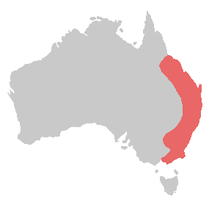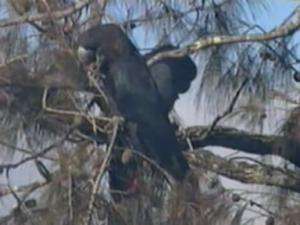Glossy black cockatoo
| Glossy black cockatoo | |
|---|---|
.jpg) | |
| C. l. halmaturinus on Kangaroo Island | |
| Scientific classification | |
| Kingdom: | Animalia |
| Phylum: | Chordata |
| Class: | Aves |
| Order: | Psittaciformes |
| Superfamily: | Cacatuoidea |
| Family: | Cacatuidae |
| Subfamily: | Calyptorhynchinae |
| Genus: | Calyptorhynchus |
| Subgenus: | Calyptorhynchus |
| Species: | C. lathami |
| Binomial name | |
| Calyptorhynchus lathami Temminck, 1807 | |
| Subspecies | |
|
C. (C.) l. lathami | |
 | |
| Glossy black cockatoo range (in red) | |
The glossy black cockatoo (Calyptorhynchus lathami), is the smallest member of the subfamily Calyptorhynchinae found in Australia. Adult glossy black cockatoos may reach 50 cm (19.5 in) in length. They are sexually dimorphic. Males are blackish brown in colour, except their prominent red tail bands; the females are dark brownish with some yellow spotting. Three subspecies are recognised.
Taxonomy
The glossy black cockatoo was first described by Dutch naturalist Coenraad Jacob Temminck in 1807. The scientific name honours the English ornithologist John Latham.
The glossy black cockatoo's closest relative is the red-tailed black cockatoo; the two species form the subgenus Calyptorhynchus within the genus of the same name.[2] They are distinguished from the other black cockatoos of the subgenus Zanda by their significant sexual dimorphism and calls of the juveniles; one a squeaking begging call, the other a vocalization when swallowing food.[2][3]
Subspecies
The three subspecies were proposed by Schodde et al. in 1993,[4] although parrot expert Joseph Forshaw has reservations due to their extremely minimal differences.[5]
- C. l. lathami: (Rare) The eastern subspecies found between southeastern Queensland and Mallacoota in Victoria, with isolated pockets in Eungella in central Queensland and the Riverina and Pilliga forest.[6] It is associated with casuarina woodland.
- C. l. erebus Occurs in central Queensland from Eungulla near Mackay south to Gympie[4]
- C. l. halmaturinus: (Endangered) The Kangaroo Island subspecies has been listed by the Australian Government as endangered. Restricted to the northern and western parts of the island, the population may be as low as 100 individuals. It feeds on the Drooping She-oak (Allocasuarina verticillata) and the Sugar Gum (Eucalyptus cladocalyx)[7] In particular, the bird specialises in the most recent season's cones of Allocasuarina verticillata over older cones of that species and Allocasuarina littoralis. It holds the cones in its foot and shreds them with its powerful bill before removing the seeds with its tongue.[8]
Description
Like the related red-tailed black cockatoo, this species is sexually dimorphic. The male glossy black cockatoo is predominantly black with a chocolate brown head and striking caudal red patches. The female is a duller dark brown, with flecks of yellow in the tail and collar. The female's tail is barred whereas the male's tail is patched. An adult will grow to be about 46–50 cm (18–19.5 in) in length. The birds are found in open forest and woodlands, and usually feed on seeds of the she-oak (Casuarina spp.)
Conservation Status

Like most species of parrots, the glossy black cockatoo is protected by the Convention on International Trade in Endangered Species of Wild Fauna and Flora (CITES) with its placement on the Appendix II list of vulnerable species, which makes the import, export, and trade of listed wild-caught animals illegal.[9][10]
Glossy black cockatoos generally are not listed as threatened on the Environment Protection and Biodiversity Conservation Act 1999, however the Kangaroo Island race, C. lathami halmaturinis was added to the list as endangered.
State of Victoria, Australia
- The eastern subspecies of the glossy black cockatoo (C. l. lathami) is listed as threatened on the Victorian Flora and Fauna Guarantee Act (1988).[11] Under this Act, an Action Statement for the recovery and future management of this species has not been prepared.[12]
- On the 2007 advisory list of threatened vertebrate fauna in Victoria, the subspecies C. l. lathami is listed as vulnerable.[13]
State of Queensland, Australia
C. lathami lathami is listed as vulnerable by the Environmental Protection Agency (Queensland).
References
- ↑ BirdLife International (2012). "Calyptorhynchus lathami". IUCN Red List of Threatened Species. Version 2013.2. International Union for Conservation of Nature. Retrieved 26 November 2013.
- 1 2 Forshaw, p. 89
- ↑ Courtney, J (1996). "The juvenile food-begging calls, food-swallowing vocalisation and begging postures in Australian Cockatoos". Australian Bird Watcher. 16: 236–49.
- 1 2 Schodde R, Mason IJ & Wood JT. (1993). Geographical differentiation in the Glossy Black Cockatoo Calyptorhynchus lathami (Temminck), and its history. Emu 93: 156-166
- ↑ Forshaw, Joseph M. & Cooper, William T. (2002): Australian Parrots (3rd ed). Press, Willoughby, Australia. ISBN 0-9581212-0-6
- ↑ Blakers M, Davies SJJF, Reilly PN (1984) The Atlas of Australian Birds. RAOU and Melbourne University press, Melbourne.
- ↑ Joseph L (1982) The Glossy Black Cockatoo on Kangaroo Island Emu 82 46-49
- ↑ Crowley, GM; Garnett S (2001). "Food value and tree selection by Glossy Black-Cockatoos Calyptorhynchus lathami". Austral Ecology. 26 (1): 116–26. doi:10.1046/j.1442-9993.2001.01093.x.
- ↑ "Appendices I, II and III". CITES. 2009-05-22. Retrieved 18 March 2010.
- ↑ Cameron, p. 169.
- ↑ Department of Sustainability and Environment, Victoria
- ↑ Department of Sustainability and Environment, Victoria
- ↑ Victorian Department of Sustainability and Environment (2007). Advisory List of Threatened Vertebrate Fauna in Victoria - 2007. East Melbourne, Victoria: Department of Sustainability and Environment. p. 15. ISBN 978-1-74208-039-0.
Cited texts
- Cameron, Matt (2008). Cockatoos (1st ed.). Collingwood, Victoria: CSIRO Publishing. ISBN 0-643-09232-3.
- Forshaw, Joseph M; William T. Cooper (2002). Australian Parrots (3rd ed.). Robina: Alexander Editions. ISBN 0-9581212-0-6.
- Flegg, Jim. Birds of Australia: Photographic Field Guide Sydney: Reed New Holland, 2002. (ISBN 1-876334-78-9)
- Garnett, S. (1993) Threatened and Extinct Birds Of Australia. RAOU. National Library, Canberra. ISSN 0812-8014
External links
- World Parrot Trust Parrot Encyclopedia - Species Profiles
- Threatened species and ecological communities
- GlossyBlackCockatoo.com
| Wikimedia Commons has media related to Calyptorhynchus lathami. |
| Wikispecies has information related to: Calyptorhynchus lathami |
